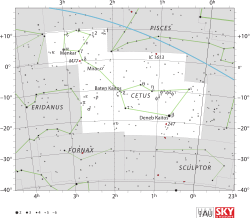GJ 1005
| Observation data Epoch J2000 Equinox J2000 | |
|---|---|
| Constellation | Cetus |
| Right ascension | 00h 15m 28.11090s[1] |
| Declination | −16° 08′ 01.6303″[1] |
| Apparent magnitude (V) | 11.483[2] |
| Characteristics | |
| Spectral type | M3.5V[3] |
| Astrometry | |
| Radial velocity (Rv) | -26.43 ± 0.1[4] km/s |
| Proper motion (μ) | RA: 731.83[1] mas/yr Dec.: -607.73[1] mas/yr |
| Parallax (π) | 200.53 ± 9.41[1] mas |
| Distance | 16.3 ± 0.8 ly (5.0 ± 0.2 pc) |
| Absolute magnitude (MV) | 12.70 ± 0.01 / 15.12 ± 0.09[3] |
| Orbit[3] | |
| Period (P) | 1666.1 ± 2.5 d |
| Semi-major axis (a) | 0.3037 ± 0.0005″ |
| Eccentricity (e) | 0.364 ± 0.001 |
| Inclination (i) | 146.1 ± 0.2° |
| Longitude of the node (Ω) | 62.8 ± 0.4° |
| Periastron epoch (T) | JD 2449850.4 ± 0.8 |
| Argument of periastron (ω) (secondary) | 166.6 ± 0.5° |
| Details[3] | |
| GJ 1005 A | |
| Mass | 0.179 ± 0.002 M☉ |
| GJ 1005 B | |
| Mass | 0.112 ± 0.001 M☉ |
| Other designations | |
| Database references | |
| SIMBAD | data |
| ARICNS | A |
| B | |

Cetus Constellation map
GJ 1005 is a system of two red dwarfs, located in constellation Cetus at 19.58 light-years from Earth.[5] The primary star is a M4V class star while the secondary is a class M7V.
The system was observed with the Hubble Space Telescope in the 1990s with its Fine Guidance Sensor.[5] This data helped determine the mass of each of the components of L722-22/ LHS 1047 / GJ 1005.[5]
References
- 1 2 3 4 5 van Leeuwen, F.; et al. (2007). "Validation of the new Hipparcos reduction". Astronomy and Astrophysics. 474 (2): 653–664. arXiv:0708.1752. Bibcode:2007A&A...474..653V. doi:10.1051/0004-6361:20078357.
- ↑ Koen, C.; Kilkenny, D.; van Wyk, F.; Marang, F. (2010). "UBV(RI)C JHK observations of Hipparcos-selected nearby stars". Monthly Notices of the Royal Astronomical Society. 403 (4): 1949–1968. Bibcode:2010MNRAS.403.1949K. doi:10.1111/j.1365-2966.2009.16182.x.
- 1 2 3 4 Benedict, G. F.; Henry, T. J.; Franz, O. G.; McArthur, B. E.; Wasserman, L. H.; Jao, Wei-Chun; Cargile, P. A.; Dieterich, S. B.; Bradley, A. J.; Nelan, E. P.; Whipple, A. L. (2016). "The Solar Neighborhood. XXXVII. The Mass–Luminosity Relation for Main-Sequence M Dwarfs". The Astronomical Journal. 152 (5): 141. arXiv:1608.04775. Bibcode:2016AJ....152..141B. doi:10.3847/0004-6256/152/5/141.
- ↑ Nidever, David L.; et al. (2013). "Radial Velocities for 889 Late-Type Stars". The Astrophysical Journal Supplement Series. 141 (2): 503–522. arXiv:astro-ph/0112477. Bibcode:2002ApJS..141..503N. doi:10.1086/340570.
- 1 2 3 Hershey, John L.; Taff, L. G. (1998-01-01). "Hubble Space Telescope Fine Guidance Sensor Astrometry of the Low-Mass Binary L722-22". The Astronomical Journal. 116 (3): 1440. Bibcode:1998AJ....116.1440H. doi:10.1086/300516. ISSN 1538-3881.
This article is issued from
Wikipedia.
The text is licensed under Creative Commons - Attribution - Sharealike.
Additional terms may apply for the media files.